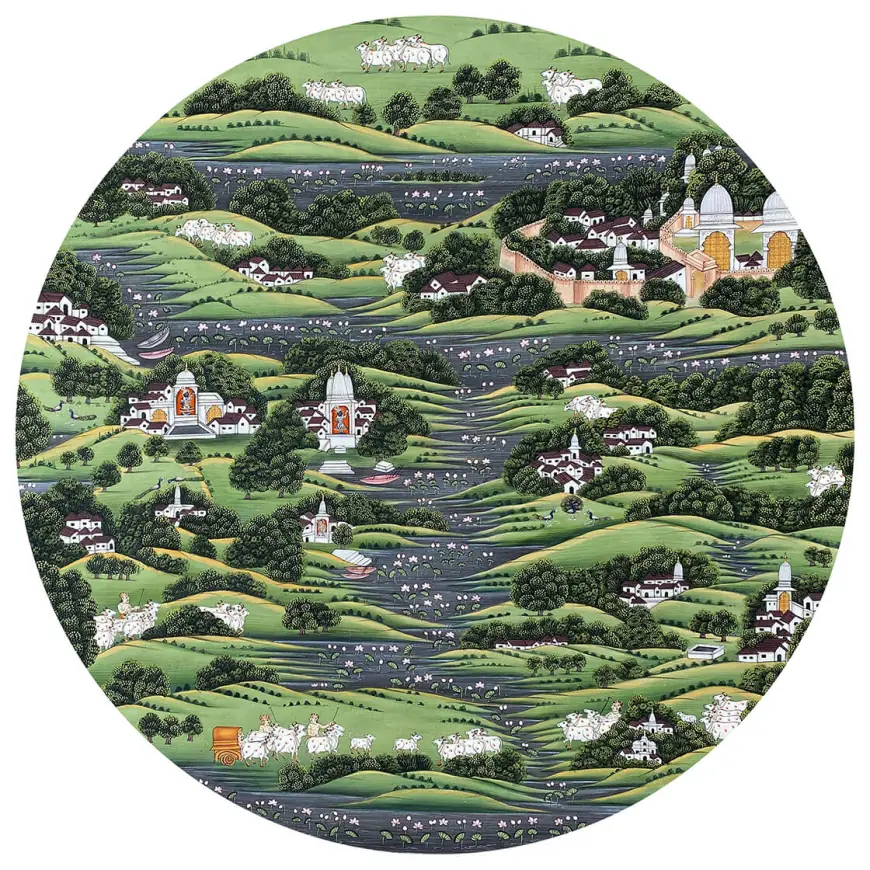Pichwai Paintings of Nathdwara: Devotion Woven in Color and Cloth
Nestled in the sacred town of Nathdwara near Udaipur, Rajasthan, the tradition of Pichwai Paintings Nathdwara dates back over four centuries. Rooted in deep devotion, these paintings were created as backdrops for the image of Shrinathji, a child form of Lord Krishna, central to the Pushtimarg sect. According to legend, the swaroop (sacred image) of Shrinathji was brought to Nathdwara by Saint Vallabhacharya from Govardhan Parvat to protect it from Mughal invasions. Following this divine migration, a community of highly skilled artists settled near the temple, in what came to be known as chitrakaron ki gali — the painters’ street. The early development of Pichwai Paintings Nathdwara was heavily influenced by various regional styles of Rajasthani art. The expressive boldness of Mewar, the fine detailing of Jaipur (influenced by Mughal painting), and the romantic elegance of Kishangarh were all absorbed into this sacred tradition. The Kishangarh School, in particular, left a lasting mark with its signature almond-shaped, elongated eyes — an aesthetic now closely associated with Nathdwara’s depiction of divine figures. Over time, the Nathdwara Paintings developed their own distinctive visual language. They feature dreamy-eyed cows, robust human forms with fuller bodies and narrow waists, flowing bell-shaped skirts, and rich ornamentation. Most importantly, Shrinathji is depicted with a dark blue-black complexion, crescent-shaped eyes that look down in humility, and dressed in elaborate Pushtimarg attire. These visual elements were not merely decorative — they held symbolic and spiritual meaning, embodying grace, divinity, and ritual importance. Traditionally, these paintings were changed according to the seasons and festivals and formed an essential part of temple rituals. Today, however, the scope of Pichwai Paintings Nathdwara has expanded far beyond temple walls. With changing times and tastes, contemporary artists have brought the art form into modern relevance. The spiritual essence remains, but the medium has adapted — appearing in galleries, private collections, and contemporary interior spaces. Modern curators and artists like Pooja Singhal have played an instrumental role in this revival. Through her vision at Pichwai Tradition And Beyond, her reinterpretations of maintain the original devotional character while introducing updated formats, textures, and scale. By blending tradition with innovation, Pichwai Tradition And Beyond has brought new life to , making them not just cultural heirlooms, but living art forms that continue to speak to newer generations and resonate in both spiritual and contemporary spaces.

Nestled in the sacred town of Nathdwara near Udaipur, Rajasthan, the tradition of Pichwai Paintings Nathdwara dates back over four centuries. Rooted in deep devotion, these paintings were created as backdrops for the image of Shrinathji, a child form of Lord Krishna, central to the Pushtimarg sect. According to legend, the swaroop (sacred image) of Shrinathji was brought to Nathdwara by Saint Vallabhacharya from Govardhan Parvat to protect it from Mughal invasions. Following this divine migration, a community of highly skilled artists settled near the temple, in what came to be known as chitrakaron ki gali — the painters’ street.

The early development of Pichwai Paintings Nathdwara was heavily influenced by various regional styles of Rajasthani art. The expressive boldness of Mewar, the fine detailing of Jaipur (influenced by Mughal painting), and the romantic elegance of Kishangarh were all absorbed into this sacred tradition. The Kishangarh School, in particular, left a lasting mark with its signature almond-shaped, elongated eyes — an aesthetic now closely associated with Nathdwara’s depiction of divine figures.
Over time, the Nathdwara Paintings developed their own distinctive visual language. They feature dreamy-eyed cows, robust human forms with fuller bodies and narrow waists, flowing bell-shaped skirts, and rich ornamentation. Most importantly, Shrinathji is depicted with a dark blue-black complexion, crescent-shaped eyes that look down in humility, and dressed in elaborate Pushtimarg attire. These visual elements were not merely decorative — they held symbolic and spiritual meaning, embodying grace, divinity, and ritual importance.
Traditionally, these paintings were changed according to the seasons and festivals and formed an essential part of temple rituals. Today, however, the scope of Pichwai Paintings Nathdwara has expanded far beyond temple walls. With changing times and tastes, contemporary artists have brought the art form into modern relevance. The spiritual essence remains, but the medium has adapted — appearing in galleries, private collections, and contemporary interior spaces.

Modern curators and artists like Pooja Singhal have played an instrumental role in this revival. Through her vision at Pichwai Tradition And Beyond, her reinterpretations of maintain the original devotional character while introducing updated formats, textures, and scale. By blending tradition with innovation, Pichwai Tradition And Beyond has brought new life to , making them not just cultural heirlooms, but living art forms that continue to speak to newer generations and resonate in both spiritual and contemporary spaces.
What's Your Reaction?
 Like
0
Like
0
 Dislike
0
Dislike
0
 Love
0
Love
0
 Funny
0
Funny
0
 Angry
0
Angry
0
 Sad
0
Sad
0
 Wow
0
Wow
0

















































